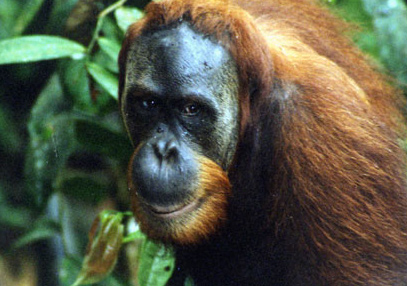Global warming puts primates at greater risk
Global warming puts primates at greater risk
mongabay.com
October 25, 2007
29 percent of the world’s primate species are in danger of going extinct warns a new report from the Primate Specialist Group of IUCN’s Species Survival Commission (SSC) and the International Primatological Society (IPS).
Titled Primates in Peril: The World’s 25 Most Endangered Primates—2006—2008, the report says that climate change could exacerbate the many threats already facing primates: deforestation, wildlife trafficking, disease outbreaks, and commercial hunting. It warns that some species — including Miss Waldron’s red colobus of Ivory Coast and Ghana, which may already be extinct, and the Horton Plains slender loris of Sri Lanka, which has been sighted only four times since 1937 — are on the brink of extinction.
 Sumatran orangutan (#25 on the list). Photo by Jen Caldwell |
“You could fit all the surviving members of these 25 species in a single football stadium; that’s how few of them remain on Earth today,” said Russell A. Mittermeier, president of Conservation International and chair of the IUCN/SSC Primate Specialist Group. “The situation is worst in Asia, where tropical forest destruction and the hunting and trading of monkeys puts many species at terrible risk. Even newly discovered species are severely threatened from loss of habitat and could soon disappear.”
The list includes eight primates that have appeared on the previous three lists published in 2000, 2002, and 2004. Six other species are first-timers, including a recently discovered tarsier from Indonesia that has yet to be formally named.
Madagascar and Vietnam lead the list with four primates, while Indonesia has three, followed by Sri Lanka, Tanzania, Ivory Coast, Ghana and Colombia with two each, and one each from China, Cameroon, Equatorial Guinea, Kenya, Nigeria, Myanmar, Bangladesh, India, Peru, Venezuela and Ecuador.
All 25 primates on the new list are found in the world’s 34 biodiversity hotspots identified by Conservation International (CI). These areas cover just 2.3 percent of Earth’s land surface but house over 50 percent of all terrestrial plant and animal diversity. Habitat destruction and market hunting are significant threats in many of these areas, though the report notes that “climate change is altering the habitats of many species, leaving those with small ranges even more vulnerable to extinction,” according to CI.
Scientists say protecting critical habitat will not only safeguard endangered primates but help slow greenhouse gas emissions. Presently, tropical deforestation accounts for 15-20 percent of global emissions–more than the entire transpiration sector.
“By protecting the world’s remaining tropical forests, we save primates and other endangered species while preventing more carbon dioxide from entering the atmosphere to warm the climate,” Mittermeier noted.
The World’s 25 Most Endangered Primates:
- Greater bamboo lemur (Prolemur simus); Madagascar
- White-collared lemur (Eulemur albocollaris); Madagascar
- Sahamalaza Peninsula sportive lemur (Lepilemur sahamalazensis); Madagascar
- Silky sifaka (Propithecus candidus); Madagascar
- Cross River gorilla (Gorilla gorilla diehli); Nigeria, Cameroon
- Roloway monkey (Cercopithecus diana roloway); Ivory Coast, Ghana
- Rondo dwarf galago (Galagoides rondoensis); Tanzania
- Tana River red colobus (Procolobus rufomitratus); Kenya
- Miss Waldron’s red colobus (Procolobus badius); Ivory Coast, Ghana
- Kipunji (Rungwecebus kipunji); Tanzania
- Pennant’s red colobus (Procolobus pennantii pennantii); Equatorial Guinea (Island of Bioko)
- Variegated spider monkey (Ateles hybridus); Colombia, Venezuela
- Brown-headed spider monkey (Ateles fusciceps); Colombia, Ecuador
- Peruvian yellow-tailed woolly monkey (Oreonax flavicauda); Peru
- Western Hoolock gibbon (Hoolock hoolock); Bangladesh, India, Myanmar
- Horton Plains slender loris (Loris tardigradus nycticeboides); Sri Lanka
- Western purple-faced langur (Semnopithecus vetulus nestor); Sri Lanka
- Pig-tailed langur (Simias concolor); Indonesia (Mentawai Islands)
- Siau Island tarsier (Tarsius sp.); Indonesia
- Delacour’s langur (Trachypithecus delacouri); Vietnam
- Golden-headed langur (Trachypithecus poliocephalus poliocephalus); Vietnam
- Grey-shanked douc (Pygathrix cinerea); Vietnam
- Tonkin snub-nosed monkey (Rhinopithecus avunculus); Vietnam
- Hainan black-crested gibbon (Nomascus hainanus); China (Hainan Island)
- Sumatran orangutan (Pongo abelii); Indonesia (Sumatra)
This article is based on a news release from CI